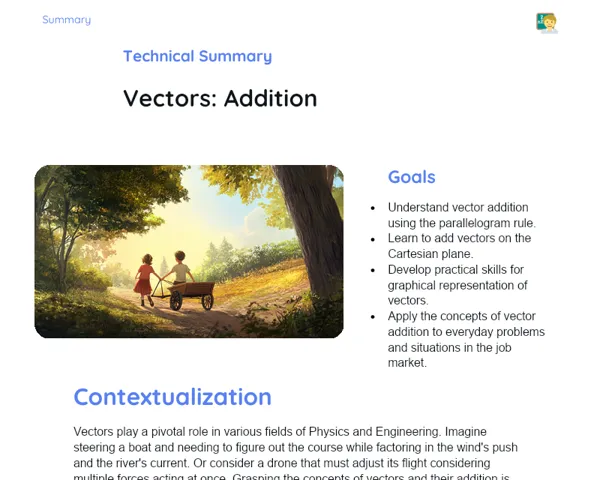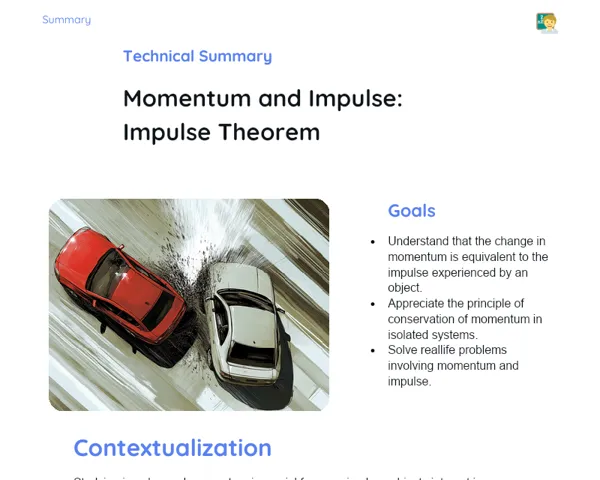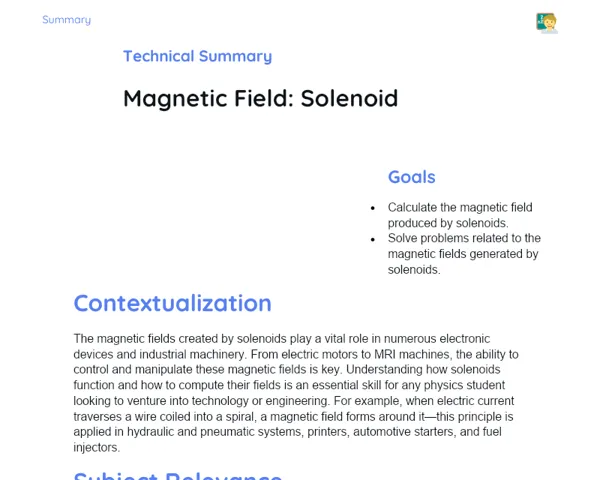Summary Tradisional | Magnetic Field: Coil
Contextualization
The magnetic field produced by coils is a fundamental concept in physics with numerous practical uses in our everyday lives. A coil consists of a conductor wound into several turns, and when electric current flows through it, a magnetic field is generated. The strength of this field depends on the number of turns in the coil, the magnitude of the electric current, and the material of the core. This phenomenon enables the creation of controlled magnetic fields, which are vital for the functioning of many electrical and electronic devices.
Coils find applications in various equipment, from electric motors and transformers to medical apparatus like MRI machines. The capacity to generate specific magnetic fields is crucial for the operation of these devices, facilitating processes such as the conversion of electrical energy into mechanical motion or the transfer of electrical signals. Grasping how coils work and the calculations related to the magnetic field they produce is essential for the development and upkeep of technologies that enhance our daily lives.
To Remember!
Definition and Structure of a Coil
A coil is an arrangement comprising a conductor wound into multiple turns. The design of the coil facilitates the generation of a magnetic field when electric current flows through it. This magnetic field is directly proportional to the number of turns and the strength of the electric current crossing through the coil.
The shape of the coil may vary, but one of the common forms is the cylindrical coil, where the wire is spiraled around a cylinder. Another significant type is the toroidal coil, where the wire is shaped into a ring. In both scenarios, the magnetic field generated is stronger inside the coil due to the accumulation of field lines.
Besides the number of turns and the electric current, the material of the coil's core also affects the generated magnetic field. Cores made of ferromagnetic materials, such as iron, amplify the magnetic field—a factor that enhances efficiency in applications needing robust magnetic fields.
-
Composition of a coil: conductor wound into multiple turns.
-
Variation in coil shapes: cylindrical and toroidal.
-
Impact of the core material on the produced magnetic field.
Ampère's Law
Ampère's Law is crucial for determining the magnetic field produced by an electric current. It connects the circulation of the magnetic field along a closed loop to the electric current flowing through the area enclosed by that loop. Mathematically, it can be expressed as ∮B·dl = μ₀I, where B represents the magnetic field, dl is an element of length of the closed path, μ₀ is the permeability of free space, and I is the electric current.
Within the framework of coils, Ampère's Law is instrumental in calculating the strength of the magnetic field within the coil. For a long coil, often termed a solenoid, the magnetic field can be simplified to B = μ₀(N/L)I, with N being the number of turns, L the length of the coil, and I the electric current. This formula is applicable for the interior of the coil, where the magnetic field is uniform and aligned with the coil's axis.
Ampère's Law serves as a vital tool for analyzing magnetic fields across various configurations of electric currents, allowing calculations of magnetic fields in numerous scenarios—from straight wires to intricate coils—ultimately aiding the understanding and practical application of electromagnetism principles.
-
Connection between the circulation of the magnetic field and electric current.
-
Mathematical representation: ∮B·dl = μ₀I.
-
Utilization of Ampère's Law in coils: B = μ₀(N/L)I.
Magnetic Field Inside a Long Coil
The magnetic field within a long coil, or solenoid, is consistent and parallel to the coil's axis. This uniformity arises from symmetry and the significant number of turns, which concentrates the field lines inside the coil, resulting in a nearly constant magnetic field.
To compute the magnetic field inside a solenoid, we apply the formula B = μ₀(N/L)I. In this equation, B indicates the magnetic field, μ₀ is the permeability of free space, N is the number of turns, L denotes the length of the coil, and I is the electric current. This formula is valid for long coils, where the end effects can be disregarded.
Outside the coil, the magnetic field is considerably weaker compared to the interior due to the dispersion of the field lines. Practically, this implies that solenoids are employed to create strong and controlled magnetic fields within a specific region, such as in physics experiments, medical equipment, and electromagnetic control devices.
-
Uniform and parallel magnetic field along the axis inside a long coil.
-
Calculation formula: B = μ₀(N/L)I.
-
Weak magnetic field outside the coil due to dispersion of field lines.
Practical Applications of Coils
Coils have diverse practical applications across technology and science. For instance, in electric motors, coils are utilized to create magnetic fields that interact with either permanent magnets or other coils to produce rotary motion. This principle is fundamental to the working of electric vehicles, fans, and many other gadgets that rely on motors.
In transformers, coils serve to transfer electrical energy between two circuits via electromagnetic induction. The relationship between the number of turns in the primary and secondary coils determines changes in voltage, facilitating the efficient conversion of energy at varying voltage levels for electrical distribution and usage in electronic devices.
Another significant application is in medical devices like MRI machines, where coils produce magnetic fields that interact with the human body to generate detailed images. Coils also play a critical role in inductors, which store energy, filter signals, and stabilize currents in electronic circuits.
-
Role of coils in electric motors for generating rotary motion.
-
Function of coils in transformers for energy transfer.
-
Use in MRI machines for producing detailed images.
-
Significance of inductors in electronic circuitry.
Key Terms
-
Magnetic Field: The area surrounding a magnetic material or an electric current where magnetic forces are detectable.
-
Coil: A device constructed from a conductor wound into several turns, employed to generate a magnetic field.
-
Ampère's Law: The correlation between the circulation of the magnetic field along a closed loop and the electric current that traverses the area enclosed by that loop.
-
Solenoid: A lengthy coil with a uniform magnetic field inside, parallel to the coil's axis.
-
Electric Current: A steady flow of electric charges through a conductor.
-
Number of Turns: The total count of wire loops or turns within a coil.
-
Permeability of Free Space (μ₀): A physical constant that describes free space's ability to harbor a magnetic field.
-
Magnetic Resonance: A medical imaging technique that employs magnetic fields and radio waves to generate detailed images of organs and tissues.
Important Conclusions
In this lesson, we delved into the magnetic field generated by coils, comprehending their structure and role. We explored how factors like the number of turns, electric current, and core material influence the strength of the magnetic field produced. We applied Ampère's Law to compute the magnetic field inside a long coil, underscoring the formula B = μ₀(N/L)I as an essential tool for such calculations.
Beyond theoretical aspects, we discussed practical applications of coils in electric motors, transformers, and medical devices such as MRI machines. These examples underscore the significance of coils in technologies we encounter daily, from generating motion in motors to crafting detailed images of the human anatomy.
Grasping the concepts covered is pivotal for fostering new technologies and maintaining electromagnetic devices. We encourage students to delve deeper into the topic, as mastering this field can pave the way for diverse academic and professional prospects in electronics and physics.
Study Tips
-
Revise basic concepts of electromagnetism, including Ampère's Law and the solenoid magnetic field formula.
-
Engage in problem-solving related to calculating the magnetic field produced by coils to solidify understanding.
-
Investigate the practical uses of coils in different technological devices and their real-world implications.



